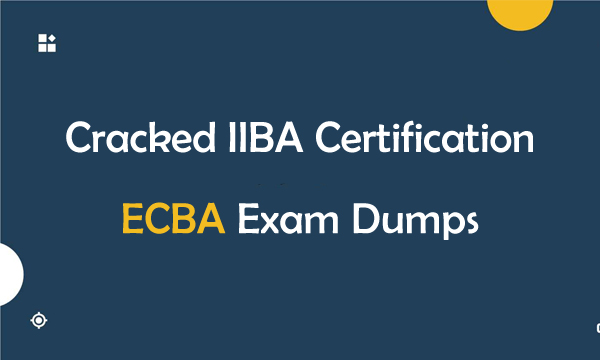Cracked IIBA Certification ECBA Exam Dumps
July 22,2020 03:16 AM
Entry Certificate in Business Analysis ECBA exam dumps have been cracked, which will be valid for you to pass the test. If you are preparing ECBA exam, you can study the latest ECBA exam dumps. ECBA covers the foundational knowledge on business analysis according to the BABOK Guide and showcases that you have the core knowledge and competencies for the in–demand field of business analysis.

ECBA IIBA Certification Information
ECBA Entry Certificate in Business Analysis exam has 50 multiple choice knowledge-based questions and must be completed in one hour.
IIBA ECBA Exam Topics
The following contents are covered in IIBA certification ECBA exam topics.
Business Analysis Knowledge
Business analysis and the BA professional 2.5%
Underlying competencies 5%
Business analysis key concepts 5%
Techniques 12.5%
BABOK Guide Knowledge Areas
Business analysis planning and monitoring 5%
Elicitation and collaboration 20%
Requirements life cycle management 20%
Strategy analysis 5%
Requirements analysis and design definition 24%
Solution evaluation 1%
Practice IIBA ECBA Exam Dumps Questions
Our IIBA Certification ECBA exam dumps questions are the latest version in the market, which can help you study the above Entry Certificate in Business Analysis ECBA topics. Share some IIBA ECBA exam dumps questions and answers below.
1.Why should a business analyst (BA) perform a cultural assessment when analyzing the current state of an enterprise?
A. To determine whether stakeholders understand the rationale for the current state of the enterprise
B. To identify the formal relationships between people working in the enterprise
C. To document the communication channels, reporting structures, and relationships in the enterprise
D. To understand the scope of decision making at different levels of the enterprise
Answer: A
2.What is a logical data model used for?
A. Abstracting a ‘conceptual data model’ to incorporate the rules of normalization to manage data integrity and relationships.
B. Abstracting a ‘physical data model’ to describe the physical organization of data and its relationships within a database.
C. Defining the logical rules that govern decisions in an organization and that define, constrain, or enable organizational operations.
D. Defining a solution independent view of how a business perceives its information without applying any constraints.
Answer: C
3.Which technique is used by business analysts (BAs) to measure the quality of requirements?
A. Acceptance and Evaluation Criteria
B. Key Performance Indicators
C. Risk Analysis and Management
D. Entity Relationship Modelling
Answer: B
4.What is the input status of requirements used by business analysts (BAs) for undertaking requirement verification activities?
A. Stated and Unconfirmed
B. Maintained and Reusable
C. Specified and Modeled
D. Validated and Prioritized
Answer: D
5.If a business analyst (BA) asks questions during the job shadowing with a subject matter expert, which approach is being used?
A. Active Observation Approach
B. Contextual Inquiry Observation
C. Inactive Observation Approach
D. Passive Observation Approach
Answer: A
ECBA Exam Dumps PDF & SOFT | 1 Year Free Update | Money Back Guarantee
- Related Suggestion
- IIBA-AAC Agile Analysis Certification Dumps April 11,2020
- CBDA Certification in Business Data Analytics Exam Dumps May 02,2024
- 2021 Updated CCBA Certification of Competency in Business Analysis Dumps May 12,2021

